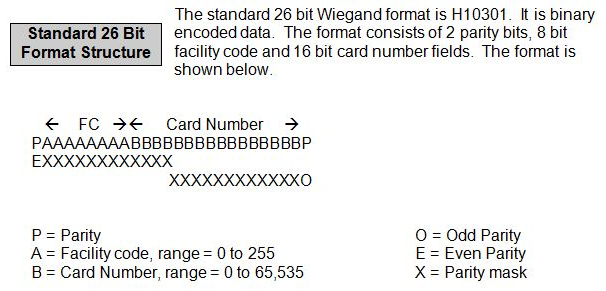|
CARD NUMBER FORMATS When a contactless or prox card is presented to a reader, the reader captures the number that is programmed into that card over a radio frequency (RF) interface. The reader then sends that number to the system that grants access to doors, networks, or applications on a PC. The various shapes that the card number might have are called formats. FACILITY CODE AND CARD NUMBERS Cards are programmed with 0s and 1s, which are often arranged into sections – the facility code or prefix which is the same for each card; and the ID number which is different for each card. The access control system looks first to see that the facility code is correct for that facility, and then it checks the ID number of the card for the requested permission. Sometimes a format is designed without a facility code, in which case each card has a longer ID number. The most common card format is the 26-bit open format, with available facility codes between 0 and 255, and ID numbers between 0 and 65,535. Other common formats are 34-bits, 35-bits (often called Corporate 1000) and 37-bits. UNIQUE CARD NUMBERS It is very important that every card enrolled in a system be recognized by that system as unique. If a particular format cannot meet the requirements of a large institution, it will be difficult to avoid the collision of ID numbers in the system. In the case of the 26-bit format, for each facility code there are only 65,535 unique ID numbers. Upon exhausting all the ID numbers for one facility code, it is possible to create another facility code and start over at 0 with new ID numbers. However, some systems are configured to only look at the ID numbers , resulting in ID number collisions. Here is an example of two cards that could cause this problem:
CARDS AND MORE THAN ONE SYSTEM Many institutions have a local access control system which manages all the prox card numbers locally. However, some institutions use a Single Sign-On application such as Imprivata, which is managed centrally for several institutions. In this configuration, a prox card number which is unique to the local access control system could collide with other prox card numbers in the enterprise SSO application, especially if the latter were only looking at the ID numbers and not the facility codes. SOLUTION As organizations grow, their card formats must grow with them, in order to provide enough unique ID numbers. Formats such as Corporate 1000, which has over 1,000,000 ID numbers per facility code, and a 32-bit format with 1000 facility codes and over 2 million ID numbers are available for programming into all types of contactless cards. ColorID has helped thousands of institutions select formats and configure their various systems and readers to read those formats.  About ColorID, LLC Every year, ColorID assists more than 1000 colleges and universities and their project managers personally oversee 700 custom projects each year, including many small and large recarding projects. ColorID offers best-in-class products and solutions, including: contactless, smart and financial cards from every major manufacturer, multiple ID printer platforms; transaction and point-of-sale software and hardware, a variety of handheld devices for identification and tracking applications and biometrics solutions, including fingerprint and iris readers. The company’s manufacturing partners include: Iris ID, HID, Fargo, Datacard, CardSmith, Gemalto, Zebra, NiSCA, Evolis, Allegion, Aptiq, Magicard, Brady People ID, Integrated Biometrics, Oberthur, NBS, Vision Database Systems and many others. Contact ColorID at 704-987-2238 or toll free in Canada and the US at 888-682-6567. Visit ColorID on the web at: www.colorid.com or email ColorID at [email protected].
0 Comments
Your comment will be posted after it is approved.
Leave a Reply. |
Categories
All
Archives
July 2020
|
WE'RE HERE TO HELP.
|
ColorID has spent over 24 years serving the ID Industry with top-level sales and support to build the ultimate trust with every customer.
|
|
|
|












